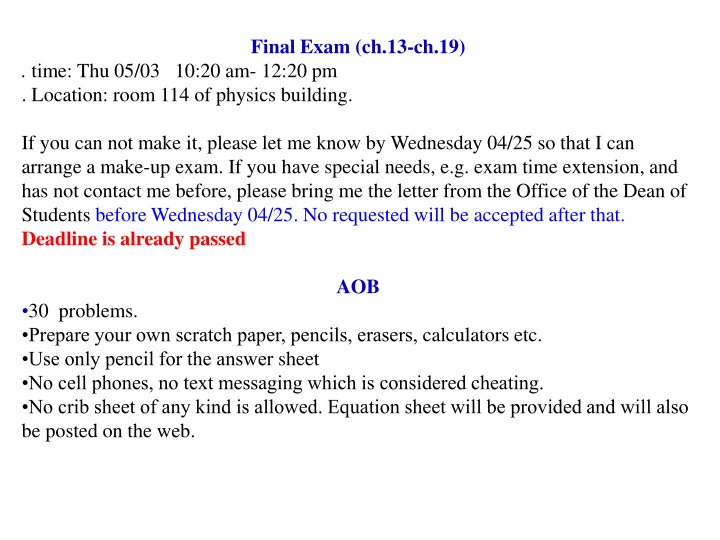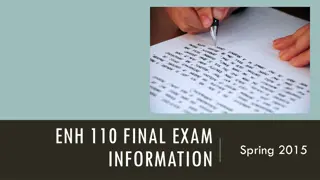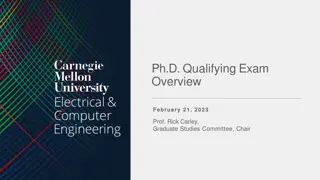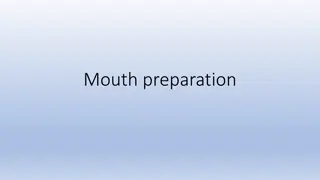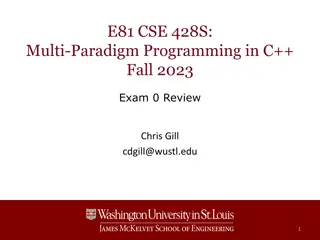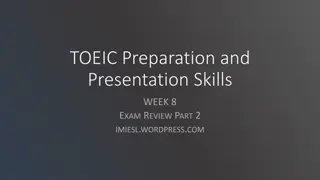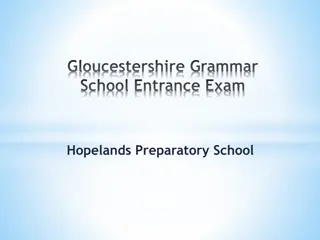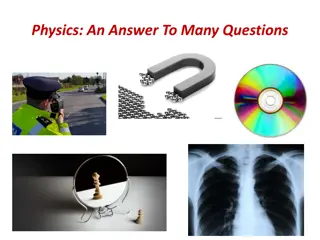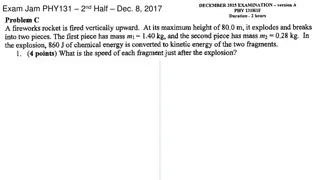Physics Final Exam: Ch.13-Ch.19 Details and Preparation
Final exam details for chapters 13 to 19 in physics, scheduled for Thu 05/03 from 10:20 am to 12:20 pm in room 114 of the physics building. Guidelines on special needs, prohibited items, and exam format included. Additional information on polarization of electromagnetic waves and a bonus quiz on polarizers provided.
Download Presentation

Please find below an Image/Link to download the presentation.
The content on the website is provided AS IS for your information and personal use only. It may not be sold, licensed, or shared on other websites without obtaining consent from the author.If you encounter any issues during the download, it is possible that the publisher has removed the file from their server.
You are allowed to download the files provided on this website for personal or commercial use, subject to the condition that they are used lawfully. All files are the property of their respective owners.
The content on the website is provided AS IS for your information and personal use only. It may not be sold, licensed, or shared on other websites without obtaining consent from the author.
E N D
Presentation Transcript
Final Exam (ch.13-ch.19) . time: Thu 05/03 10:20 am- 12:20 pm . Location: room 114 of physics building. If you can not make it, please let me know by Wednesday 04/25 so that I can arrange a make-up exam. If you have special needs, e.g. exam time extension, and has not contact me before, please bring me the letter from the Office of the Dean of Students before Wednesday 04/25. No requested will be accepted after that. Deadline is already passed AOB 30 problems. Prepare your own scratch paper, pencils, erasers, calculators etc. Use only pencil for the answer sheet No cell phones, no text messaging which is considered cheating. No crib sheet of any kind is allowed. Equation sheet will be provided and will also be posted on the web.
Mirage and Rainbow water droplet red is outside. intensity max at 42 rainbow
Polarization of Electromagnetic Waves Polarization is a measure of the degree to which the electric field (or the magnetic field) of an electromagnetic wave oscillates preferentially along a particular direction. Linear combination of many linearly polarized rays of random orientations partially polarized unpolarized linearly polarized components Looking at E head-on unequal y- and z- amplitudes equal y- and z- amplitudes
Polarizer: polarization by absorption An electric field component parallel to the transmission axis is passed by a polarizer; a component perpendicular to it is absorbed. transmission axis dichroism (tourmaline, polaroid, ) So if linearly polarized beam with E is incident on a polarizer as shown, = 2 0cos I I = cos E E y Zero if = /2, I0 if =0 If unpolarized beam is incident instead, The intensity will reduce by a factor of two. = = 2 cos /2 I I I 0 0 The light will become polarized along the transmission axis
Quiz (Bonus) A beam of un-polarized lights with intensity I is sent through two polarizers with transmission axis perpendicular to each other. What s the outgoing light intensity? a) I b) 2 I c) 0 d) 1.5 I
Example: two polarizers This set of two linear polarizers produces LP (linearly polarized) light. What is the final intensity? P1 transmits 1/2 of the unpolarized light: I1 = 1/2 I0 P2 projects out the E- field component parallel to x axis: E = I cos E E 2 1 1 2 = = 2 2 cos cos I I I = 0 if = /2 (i.e., crossed) 2 2 1 0
Quiz (bonus): Unpolarized light of intensity I0 is sent through 3 polarizers, each of the last two rotated 45 from the previous polarizer so that the last polarizer is perpendicular to the first. What is the intensity transmitted by this system? (hint: sin2(45 )=0.5) a) 0.71 I0 b) 0.50 I0 c) 0.25 I0 d) 0.125 I0 e) 0 ? = ?0 1 = 0.125?0 2 ???2(45) ???2(45)
Image by Reflection from a Plane Mirror point object Only small fraction of reflected rays received. r i Virtual image at same distance from but on the other side of the mirror as the object it is called avirtual image since no rays actually go through the image, extended object An extended object can be broken into infinite number of point objects. Image has the same height and orientation as the object.
Full Length Mirror 1 2 1 2 = = FG BC AC 1 2 1 2 ( ) = + = FH AC CE AE = = GH CD CE Only half the object (and image) size is needed.
Focal Point of a Spherical Mirror concave mirror: When parallel rays incident upon a spherical mirror, the reflected rays or the extensions of the reflected rays all converge toward a common point, the focal point of the mirror. Distance f is the focal length. f Real focal point: the point to which the reflected rays themselves pass through. This is relevant for concave mirrors. convex mirror Virtual focal point: the point to which the extensions of the reflected rays pass through. This is relevant for convex mirrors. Rays can be traversed in reverse. Thus, rays which (would) pass through F and strike the mirror will emerge parallel to the central axis. f
Locating Images only using the parallel, focal, and/or radial rays. Real images form on the side of a mirror where the objects are, and virtual images form on the opposite side.
Mirror Equation and Magnification (f = r/2) 1 s 1 s 1 f + = ' ' ' y y s s = = m ' s s m s is positive if the object is in front of the mirror (real object) s is negative if it is in back of the mirror (virtual object) s is positive if the image is in front of the mirror (real image) s is negative if it is in back of the mirror (virtual image) m is positive if image and object have the same orientation (upright) m is negative if they have opposite orientation (inverted) f and r are positive if center of curvature in front of mirror (concave) f and r are negative if it is in back of the mirror (convex)
Quiz (Bonus) An object is placed 4 cm in front of a concave mirror of focal length 20 cm. The image will be formed A. 5 cm in front of the mirror. B. 5 cm behind the mirror. C. 10 cm in front of the mirror. D. 10 cm behind the mirror. E. 0.05 cm behind the mirror. +1/x = 1/20 X = -5 cm 5 cm behind the mirror.
Quiz (bonus) A person is standing still 2 meters in front of a mirror, then the mirror is moved 1 meter towards him and then stopped. What s the distance between the person and his image before and after the mirror is moved? a) 2m and 1m b) 3m and 2m c) 4m and 2m d) 5m and 4m
